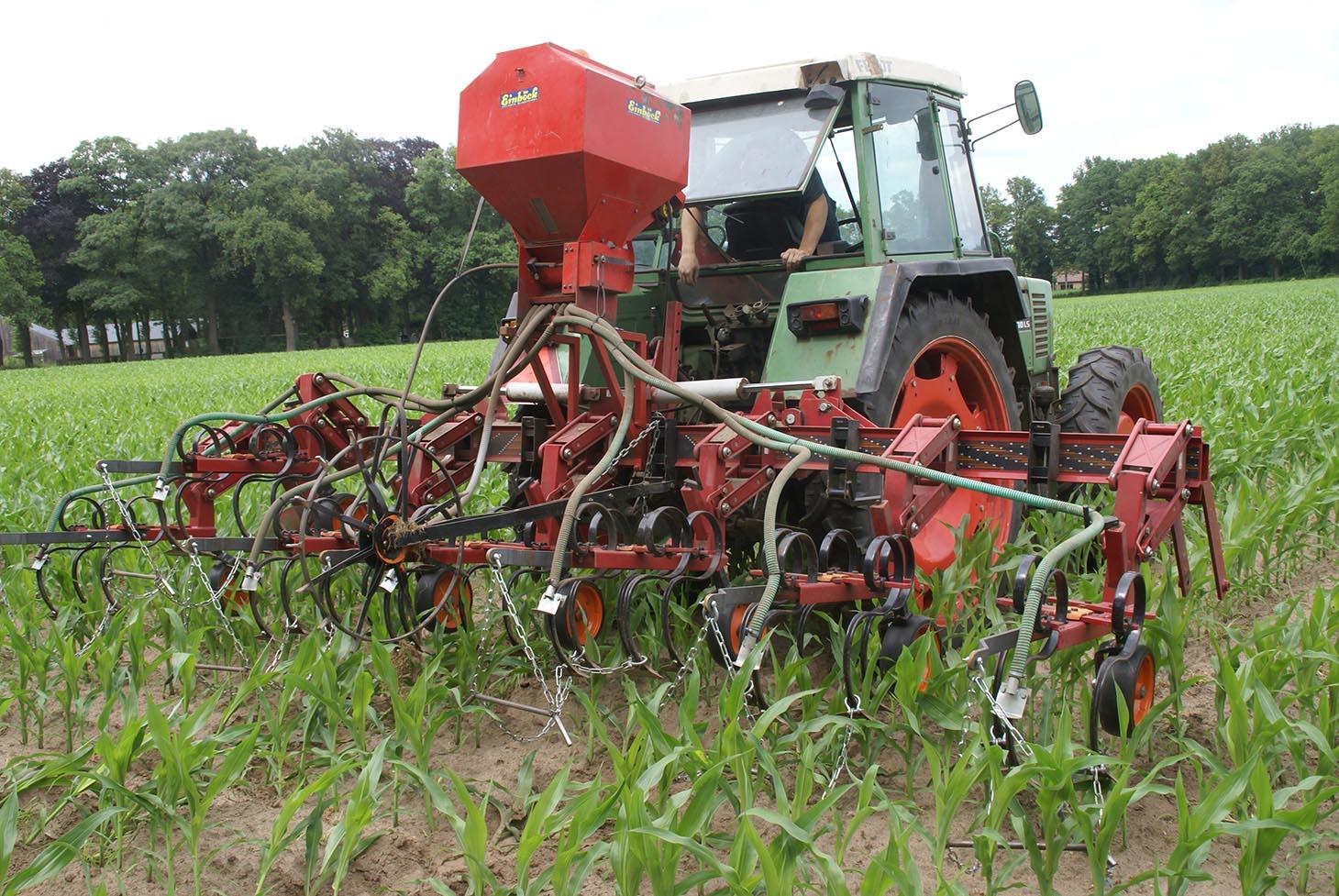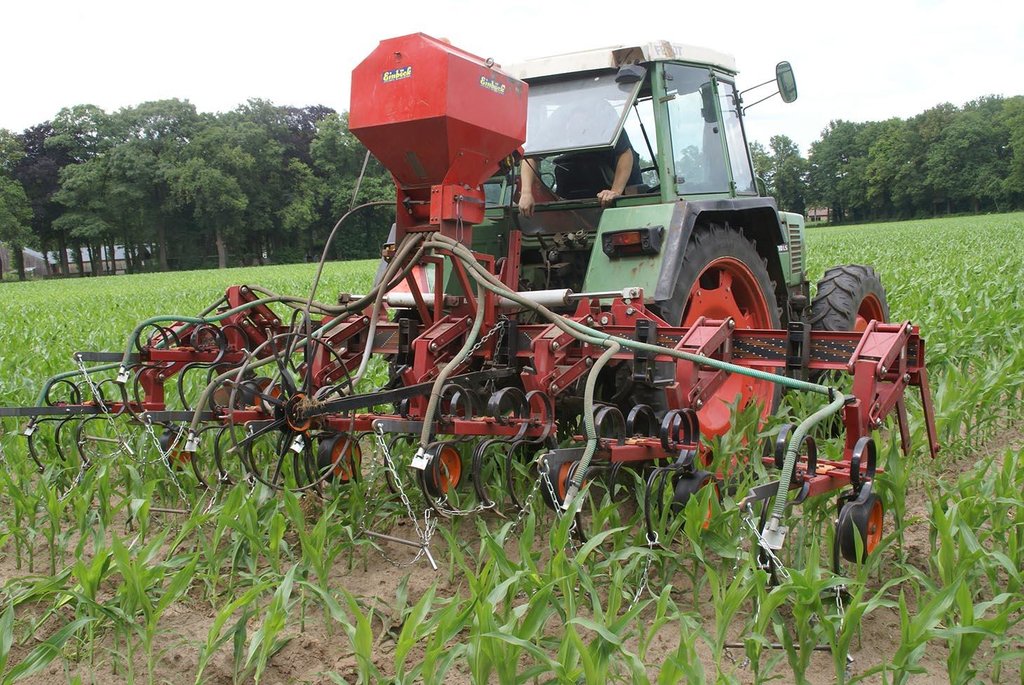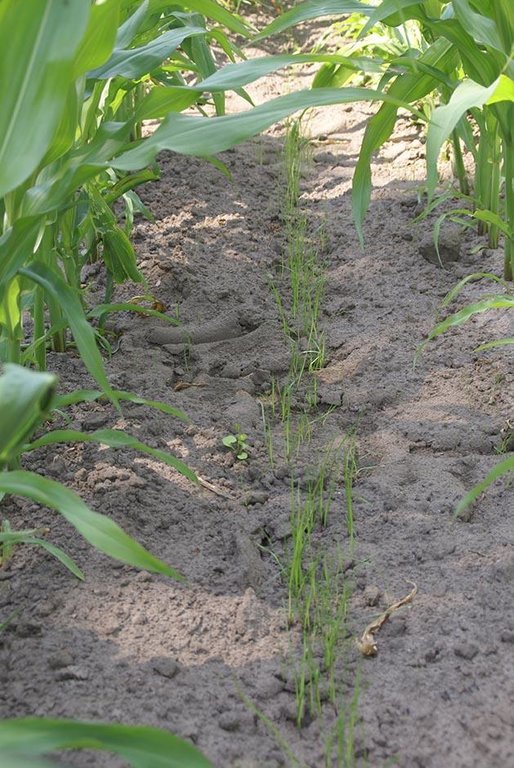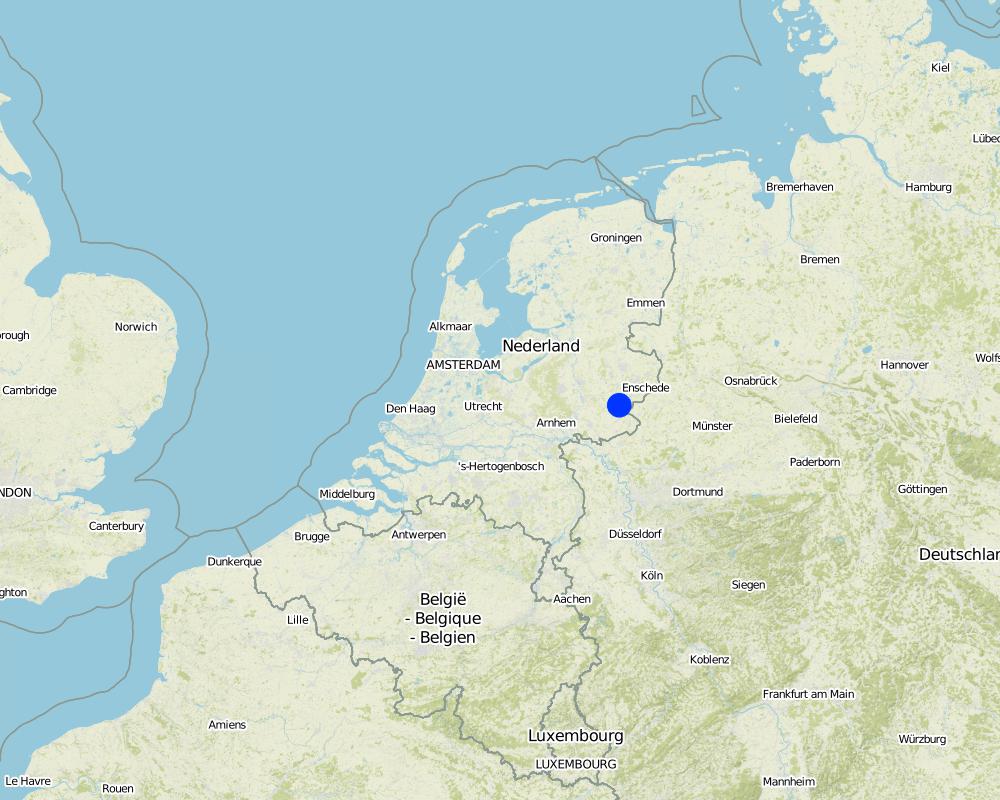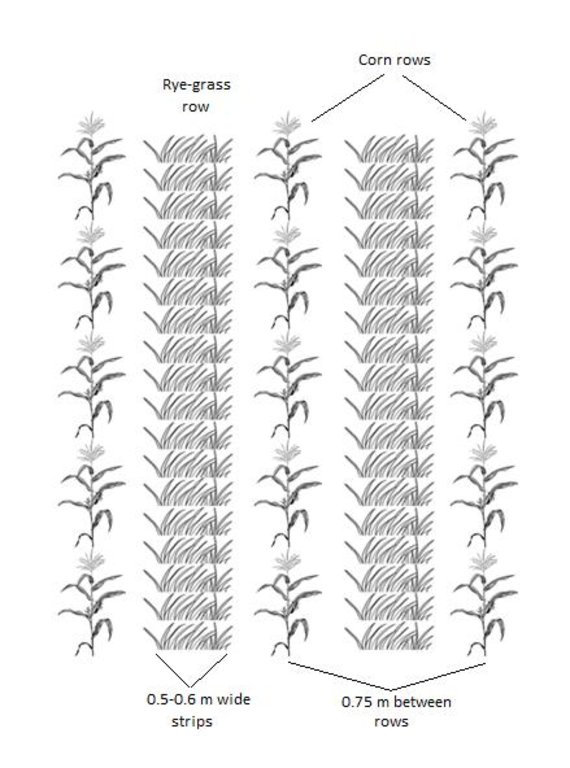Intercropping of grass and corn to increase soil organic matter [Pays-Bas]
- Création :
- Mise à jour :
- Compilateur : Jason Stuka
- Rédacteur : –
- Examinateurs : Fabian Ottiger, Alexandra Gavilano
Gras onderzaai bij mais (NL)
technologies_1248 - Pays-Bas
Voir les sections
Développer tout Réduire tout1. Informations générales
1.2 Coordonnées des personnes-ressources et des institutions impliquées dans l'évaluation et la documentation de la Technologie
Spécialiste GDT:
Smit Annemieke
Wageningen Environmental Research (Alterra)
Pays-Bas
Spécialiste GDT:
Leever Henk
HOEDuurzaam
Pays-Bas
Spécialiste GDT:
Rienks Willem
Rom3D
Pays-Bas
Nom du projet qui a facilité la documentation/ l'évaluation de la Technologie (si pertinent)
Preventing and Remediating degradation of soils in Europe through Land Care (EU-RECARE )Nom du ou des institutions qui ont facilité la documentation/ l'évaluation de la Technologie (si pertinent)
Provincie Gelderland - Pays-BasNom du ou des institutions qui ont facilité la documentation/ l'évaluation de la Technologie (si pertinent)
Hoe Duurzaam - Pays-BasNom du ou des institutions qui ont facilité la documentation/ l'évaluation de la Technologie (si pertinent)
Ministerie van Economische Zaken - Pays-BasNom du ou des institutions qui ont facilité la documentation/ l'évaluation de la Technologie (si pertinent)
Vitens - Laat Water Voor Je Werken - Pays-BasNom du ou des institutions qui ont facilité la documentation/ l'évaluation de la Technologie (si pertinent)
Wageningen Environmental Research (Alterra) - Pays-Bas1.3 Conditions relatives à l'utilisation par WOCAT des données documentées
Le compilateur et la(les) personne(s) ressource(s) acceptent les conditions relatives à l'utilisation par WOCAT des données documentées:
Oui
1.5 Référence au(x) Questionnaires sur les Approches de GDT (documentées au moyen de WOCAT)
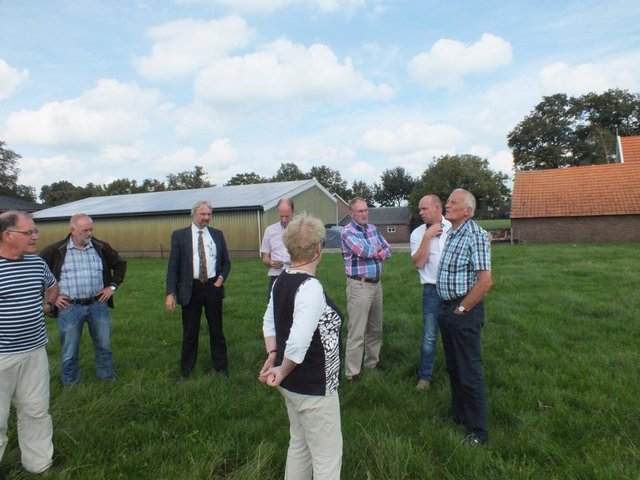
Regional process, social innovation [Pays-Bas]
Social innovation for sustained soil organic matter, clean drinking water and sustainable crop production
- Compilateur : Simone Verzandvoort
2. Description de la Technologie de GDT
2.1 Courte description de la Technologie
Définition de la Technologie:
Grass intercropping on corn fields
2.2 Description détaillée de la Technologie
Description:
Italian rye grass is sown when the corn has grown to knee height, and has not yet developed a closed cover. The grass is plowed into the soil several months after the harvest of the corn crop.
Purpose of the Technology: The purpose of the technology is to enable a good growth of the catch crop (the grass) and to increase root biomass production after the corn is harvested. This will contribute to the organic mater content of the soil, and reduce the leaching of nitrogen and potassium. After underplowing of the grass, the nitrogen and potassium will be released to the soil and become available for the next crop.
Establishment / maintenance activities and inputs: When corn is well established (between 30-60 cm height), grass is seeded between rows. A special seeder is required. Tractor must have tires that fit between corn rows. Grass germinates, but growth is reduced as corn matures and creates shade. When corn is harvested, grass continues to grow as a winter catch-crop. Some years, grass is sprayed with fertiliser to increase mineralisation. Grass is cultivated into the soil in early spring.
Natural / human environment: Multi-functional rural area with land use for agriculture, recreation, residence and nature. Dairy agriculture in small farms for Dutch standards combined with arable cropping. High livestock density.
Undulating landscape with cover sands and clayey and loamy sediments. Podzols and cambisols developed in sandy substrate. The area also has patches of anthroposols, soils enriched in Medieval times with manure and organic residues. Phosphate and nitrogen levels in these soils are in general high.
Mean monthly temperature varies between 2 and 17°C. The long-term mean annual precipitation is between 800 and 825 mm, with the lowest amounts in spring, and the highest in autumn. The long-term average annual precipitation deficit is between 200 and 240 mm.
2.3 Photos de la Technologie
2.5 Pays/ région/ lieux où la Technologie a été appliquée et qui sont couverts par cette évaluation
Pays:
Pays-Bas
Région/ Etat/ Province:
Gelderland
Autres spécifications du lieu:
Haarlo - Oude Eibergen
Spécifiez la diffusion de la Technologie:
- répartie uniformément sur une zone
Si la Technologie est uniformément répartie sur une zone, précisez la superficie couverte (en km2):
0,94
Commentaires:
Boundary points of the Technology area: Left: 52.098865, 6.563182
Right: 52.095031, 6.634282
Top: 52.111764, 6.589390
Bottom: 52.081761, 6.620607
Total area covered by the SLM Technology is 0.94 km2.
94 ha over 32 fields. 20 farmers applied this technology.
Map
×2.6 Date de mise en œuvre de la Technologie
Si l'année précise est inconnue, indiquez la date approximative: :
- il y a moins de 10 ans (récemment)
2.7 Introduction de la Technologie
Spécifiez comment la Technologie a été introduite: :
- grâce à l'innovation d'exploitants des terres
Commentaires (type de projet, etc.) :
The land users's initiative was through the application for the project Healthy Sand by a group of farmers. During the Gezond Zand Project the group organised themselves in the Foundation HOEDuurzaam. The project ran from 2012-2014 and is followed by the new project BodemRijk.
The external initiative was from the drinking water company Vitens and the Province of Gelderland in the same period.
3. Classification de la Technologie de GDT
3.2 Type(s) actuel(s) d'utilisation des terres, là où la Technologie est appliquée

Terres cultivées
- Cultures annuelles
Cultures annuelles - Précisez les cultures:
- céréales - maïs
- céréales - autres
- cultures fourragères - graminées
- plantes à racines et à tubercules - pommes de terre
Nombre de période de croissance par an: :
- 1
Précisez:
Longest growing period in days: 250Longest growing period from month to month: March - November
Est-ce que les cultures intercalaires sont pratiquées?
Oui
Si oui, précisez quelles cultures sont produites en culture intercalaire:
Intercropping of grass and corn to increase soil organic matter
Commentaires:
Major land use problems (compiler’s opinion): The main soil threat in the Olden-Eibergen Case Study area is the gradual decline of soil organic matter stocks. On average, agricultural fields have lost up till 5.4% of organic matter in the last 10 years according to farmers. This threatens the agricultural potential of the soil as well as its water holding capacity, and its potential to buffer leaching of nutrients and pesticides. In the long term, agricultural productivity will fall, costs of agricultural inputs such as manure, fertilizers, pesticides and irrigation will increase and the additional costs for cleaning drinking water withdrawn from ground water will rise.
Major land use problems (land users’ perception): The group of farmers in the area experience declining crop production, problems with too dry and too wet soils, and decreasing organic matter content in soil due to long-term monocultures of maize, the use of pig manure and legislation forcing farmers to process or export manure from their farms.
Grazingland comments: Nothing filled in in this section, since the technology applies specifically to maize cropping.
Type of grazing system comments: Nothing filled in in this section, since the technology applies specifically to maize cropping.
3.4 Approvisionnement en eau
Commentaires:
Water supply: rainfed, mixed rainfed - irrigated
3.5 Groupe de GDT auquel appartient la Technologie
- Intercropping
3.6 Mesures de GDT constituant la Technologie

pratiques agronomiques
- A1: Couverture végétale/ du sol
- A2: Matière organique/ fertilité du sol

pratiques végétales
- V1: Couverture d’arbres et d’arbustes
Commentaires:
Main measures: agronomic measures
Type of agronomic measures: cover cropping, green manure, rotations / fallows
Type of vegetative measures: aligned: -linear
3.7 Principaux types de dégradation des terres traités par la Technologie

dégradation chimique des sols
- Cn: baisse de la fertilité des sols et réduction du niveau de matière organique (non causée par l’érosion)

dégradation physique des sols
- Pc: compaction

dégradation hydrique
- Hq: baisse de la qualité des eaux souterraines
Commentaires:
Main type of degradation addressed: Cn: fertility decline and reduced organic matter content
Secondary types of degradation addressed: Pc: compaction, Hq: decline of groundwater quality
Main causes of degradation: soil management (ploughing for renewal of grassland or rotation to arable cropping), governance / institutional (Stricter manure legislation since January 2014 deriving from the EU Nitrates Directive has forced farmers to process part of the manure from their farms on-farm, or to export it from their farms.)
Secondary causes of degradation: crop management (annual, perennial, tree/shrub) (long-term monoculture of maize and intensive cropping of seed potatoes)
3.8 Prévention, réduction de la dégradation ou réhabilitation des terres dégradées
Spécifiez l'objectif de la Technologie au regard de la dégradation des terres:
- prévenir la dégradation des terres
- réduire la dégradation des terres
Commentaires:
Main goals: mitigation / reduction of land degradation
Secondary goals: prevention of land degradation
4. Spécifications techniques, activités, intrants et coûts de mise en œuvre
4.1 Dessin technique de la Technologie
Spécifications techniques (associées au dessin technique):
After the corn crop is growing, a tractor with a seeder sows Italian Rye-grass seeds between the rows of corn. The grass seeds are sown in strips parallel to the corn rows. The corn rows are 0.75 metres apart. The grass strips are usually between 0.50 and 0.60 metres wide, but this is according to the farmer's preference. this means that a spacing of between 0.075 and 0.125 metres remains bare on each side of the grass strip, between the grass and the corn.
Location: Haarlo - Oude Eibergen. Gelderland
Date: April 8 2015
Technical knowledge required for field staff / advisors: moderate
Technical knowledge required for land users: moderate
Technical knowledge required for agricultural contractor: high (technical skills are required from an agricultural contractor with a special machine to sow the grass in the already standing maize crop.)
Main technical functions: increase in organic matter, increase of biomass (quantity)
Secondary technical functions: improvement of ground cover, improvement of topsoil structure (compaction), increase in nutrient availability (supply, recycling,…), increase / maintain water stored in soil, improvement of water quality, buffering / filtering water
Cover cropping
Material/ species: Italian rye-grass
Quantity/ density: 25 kg/ha
Remarks: Between corn rows width 0.075-0.125 m bare space.
Green manure
Material/ species: Italian rye-grass
Quantity/ density: 25 kg/ha
Remarks: Between corn rows width 0.075-0.125 m bare space.
Rotations / fallows
Remarks: The Italian rye grass is worked into the soil ca 5 months after the harvest of the maize.
Aligned: -linear
Vertical interval between rows / strips / blocks (m): not applicable
Width within rows / strips / blocks (m): 0.75-1.25
Grass species: Italian rye grass
Slope (which determines the spacing indicated above): not applic%
Auteur:
Jason Stuka, Niemeijerstraat 26-II, 6701 CT, Wageningen, The Netherlands
4.2 Informations générales sur le calcul des intrants et des coûts
autre/ monnaie nationale (précisez):
Euro
Indiquez le taux de change des USD en devise locale, le cas échéant (p.ex. 1 USD = 79.9 réal brésilien): 1 USD = :
0,94
Indiquez le coût salarial moyen de la main d'œuvre par jour:
255.70
4.3 Activités de mise en place/ d'établissement
| Activité | Calendrier des activités (saisonnier) | |
|---|---|---|
| 1. | Buy a seeder |
4.4 Coûts et intrants nécessaires à la mise en place
| Spécifiez les intrants | Unité | Quantité | Coûts par unité | Coût total par intrant | % des coût supporté par les exploitants des terres | |
|---|---|---|---|---|---|---|
| Equipements | Seeder | Machine | 1,0 | 5327,05 | 5327,05 | |
| Coût total de mise en place de la Technologie | 5327,05 | |||||
| Coût total de mise en place de la Technologie en dollars américains (USD) | 5667,07 | |||||
Commentaires:
Duration of establishment phase: 0 month(s)
Life span of the seeder: 6 years
4.5 Activités d'entretien/ récurrentes
| Activité | Calendrier/ fréquence | |
|---|---|---|
| 1. | Seeding | After corn is established |
| 2. | Fertilizer | Every other year |
4.6 Coûts et intrants nécessaires aux activités d'entretien/ récurrentes (par an)
| Spécifiez les intrants | Unité | Quantité | Coûts par unité | Coût total par intrant | % des coût supporté par les exploitants des terres | |
|---|---|---|---|---|---|---|
| Equipements | Machine use | ha | 1,0 | 117,2 | 117,2 | 100,0 |
| Matériel végétal | Seeds | ha | 1,0 | 42,62 | 42,62 | 100,0 |
| Engrais et biocides | Fertilizer Hired(machine+fert) | ha | 1,0 | 9,06 | 9,06 | 100,0 |
| Coût total d'entretien de la Technologie | 168,88 | |||||
| Coût total d'entretien de la Technologie en dollars américains (USD) | 179,66 | |||||
Commentaires:
Machinery/ tools: Specific tractor to perform grass undersowing (seeder), tractor, sprayer/applicator
To seed the Rye-grass strips between the corn rows. Done a few months after the corn is seeded.
4.7 Facteurs les plus importants affectant les coûts
Décrivez les facteurs les plus importants affectant les coûts :
New equipment (Seeder) - The seeding and fertilizer applications are hired from a company. The company purchases the new equipment to seed between the corn rows.
The greatest determinate factor to the land users are then the cost of hired machine hours.
5. Environnement naturel et humain
5.1 Climat
Précipitations annuelles
- < 250 mm
- 251-500 mm
- 501-750 mm
- 751-1000 mm
- 1001-1500 mm
- 1501-2000 mm
- 2001-3000 mm
- 3001-4000 mm
- > 4000 mm
Spécifications/ commentaires sur les précipitations:
182 days of precipitation annually
Zone agro-climatique
- subhumide
Thermal climate class: temperate. Mean monthly temperatures vary between 2-17 °C (LGP 240-269 days, mean monthly temperatures vary between 2-17 °C)
5.2 Topographie
Pentes moyennes:
- plat (0-2 %)
- faible (3-5%)
- modéré (6-10%)
- onduleux (11-15%)
- vallonné (16-30%)
- raide (31-60%)
- très raide (>60%)
Reliefs:
- plateaux/ plaines
- crêtes
- flancs/ pentes de montagne
- flancs/ pentes de colline
- piémonts/ glacis (bas de pente)
- fonds de vallée/bas-fonds
Zones altitudinales:
- 0-100 m
- 101-500 m
- 501-1000 m
- 1001-1500 m
- 1501-2000 m
- 2001-2500 m
- 2501-3000 m
- 3001-4000 m
- > 4000 m
Commentaires et précisions supplémentaires sur la topographie:
Altitudinal zone: 0-100 m a.s.l. (up to 45 metres a.s.l.)
Slopes on average: Flat and gentle (Only incidental)
5.3 Sols
Profondeur moyenne du sol:
- très superficiel (0-20 cm)
- superficiel (21-50 cm)
- modérément profond (51-80 cm)
- profond (81-120 cm)
- très profond (>120 cm)
Texture du sol (de la couche arable):
- grossier/ léger (sablonneux)
- moyen (limoneux)
Matière organique de la couche arable:
- abondant (>3%)
- moyen (1-3%)
Si disponible, joignez une description complète du sol ou précisez les informations disponibles, par ex., type de sol, pH/ acidité du sol, capacité d'échange cationique, azote, salinité, etc.
Soil depth on average: Deep (A and B horizons up till 40 cm in Gleyic Podzols and Umbric Gleysols (ca 75% of the area) Hardly any soil organic matter below 15 cm. Rooting depth is up to 80 cm) and very deep (Deep topsoils rich in organic matter in the Fimic Anthrosols (12% of the area))
Soil texture is coarse/light (Most soils have a sandy texture due to the substrate consisting of cover sands) and medium (Soils in former creek valleys contain loam (Umbric Gleysols))
Soil fertility is low (most soils have a low fertility due to the sandy substrate (specifically the Gleyic Podzols, ca 40% of the area)) or very high (in Fimic Anthrosols originated due to application of farmyard manure since medieval times (12% of the area))
Topsoil organic matter is medium-high (The purpose of the pilot project is to increase soil organic matter)
Soil drainage/infiltration is good (deep ground water table (H > 40-80 cm; L>120 cm) in the sandy soils on thick substrate of cover sands (in 65% of the area)) and medium (shallow groundwater tables in the Umbric Gleysols (35% of the area))
Soil water storage capacity is very high (in the Fimic Anthrosols with high SOM in the topsoil) and medium (in the other soils, varying with the soil organic matter content)
5.4 Disponibilité et qualité de l'eau
Profondeur estimée de l’eau dans le sol:
< 5 m
Disponibilité de l’eau de surface:
moyenne
Qualité de l’eau (non traitée):
faiblement potable (traitement nécessaire)
Commentaires et précisions supplémentaires sur la qualité et la quantité d'eau:
Ground water table is <5m (in all soil types the highest level of the groundwater table during the year is <140 cm below the soil surface. The lowest level can be lower than 120 cm)
Availability of surface water is medium (from small rivers (De Berkel) and creeks)
Water quality (untreated) is poor drinking water (treatement required - levels of the pesticides Bentazon, and MCPP in the groundwater have incidentally exceeded the norms for drinking water production between 1985 and 2009.)
5.5 Biodiversité
Diversité des espèces:
- moyenne
Commentaires et précisions supplémentaires sur la biodiversité:
Soil biodiversity is high in the Fimic Anthrosols.
5.6 Caractéristiques des exploitants des terres appliquant la Technologie
Orientation du système de production:
- exploitation mixte (de subsistance/ commerciale)
Revenus hors exploitation:
- moins de 10% de tous les revenus
Niveau relatif de richesse:
- moyen
Individus ou groupes:
- individu/ ménage
Niveau de mécanisation:
- mécanisé/ motorisé
Genre:
- hommes
Indiquez toute autre caractéristique pertinente des exploitants des terres:
Land users applying the Technology are mainly common / average land users
Difference in the involvement of women and men: Most outdoor farm operations are completed by men.
Population density: 10-50 persons/km2
Annual population growth: negative
100% of the land users are average wealthy and own 100% of the land.
Off-farm income specification: Some farmers are contractual workers. Wives of farmers often have a job, e.g. at the municipality, craft work. No B&B activities or educational services.
Market orientation: Mixed (Maize is completely used to feed cows (max 20% of the area is allowed under maize); other arable crops are sold to the market. Dairy production is commercial.)
5.7 Superficie moyenne des terres utilisées par les exploitants des terres appliquant la Technologie
- < 0,5 ha
- 0,5-1 ha
- 1-2 ha
- 2-5 ha
- 5-15 ha
- 15-50 ha
- 50-100 ha
- 100-500 ha
- 500-1 000 ha
- 1 000-10 000 ha
- > 10 000 ha
Cette superficie est-elle considérée comme de petite, moyenne ou grande dimension (en se référant au contexte local)?
- moyenne dimension
Commentaires:
15-50 ha 6 land owners (source: geoinformation from the project gezpnd Zand)
50-100 15 land owners (source: geoinformation from the project gezpnd Zand)
5.8 Propriété foncière, droits d’utilisation des terres et de l'eau
Propriété foncière:
- individu, avec titre de propriété
Droits d’utilisation des terres:
- loué
- individuel
Commentaires:
All agriculture land is owned or rented by individual farmers. Some farmers lease their land to other farmers. Leased land is less well managed, resulting in lower organic matter contents. Investments in SLM would lead to a higher renting fee, or the land owner taking the land back in exploitation.
5.9 Accès aux services et aux infrastructures
santé:
- pauvre
- modéré
- bonne
éducation:
- pauvre
- modéré
- bonne
assistance technique:
- pauvre
- modéré
- bonne
emploi (par ex. hors exploitation):
- pauvre
- modéré
- bonne
marchés:
- pauvre
- modéré
- bonne
énergie:
- pauvre
- modéré
- bonne
routes et transports:
- pauvre
- modéré
- bonne
eau potable et assainissement:
- pauvre
- modéré
- bonne
services financiers:
- pauvre
- modéré
- bonne
6. Impacts et conclusions
6.1 Impacts sur site que la Technologie a montrés
Impacts socio-économiques
Production
production agricole
Commentaires/ spécifiez:
Expected increase of maize production: to 6-7 tonnes/ha. Not proven yet.
Possible competition between crop and grass. Not shown yet.
risque d'échec de la production
Commentaires/ spécifiez:
Expected. Not proven yet.
Disponibilité et qualité de l'eau
demande pour l'eau d'irrigation
Commentaires/ spécifiez:
Only for farmers with fields at higher elevations and drier soils.
Revenus et coûts
charge de travail
Commentaires/ spécifiez:
Saves seeding winter crop in autumn.
Added planning, but work is hired.
Undersowing of grass in the standing maize crops requires specific skills.
Impacts socioculturels
institutions communautaires
Commentaires/ spécifiez:
Created farmer's foundation.
connaissances sur la GDT/ dégradation des terres
Commentaires/ spécifiez:
Farmers understanding ecological impacts of farming practices and organic matter in soils.
apaisement des conflits
Commentaires/ spécifiez:
Farmers collaborating with water company.
Improved livelihoods and human well-being
Commentaires/ spécifiez:
Dairy farmers have learned more about the importance of soil organic matter for their production systems, and about the consequences of soil management on soil organic matter and other aspects of soil health. This learning was brought by the exchange of knowledge between farmers and experts, and between farmers themselves. Farmers also profited from services provided to them by the farmers' foundations: shared investments (e.g. in the manure separator) and support in the application for subsidies to finance the SLM measure.
Impacts écologiques
Cycle de l'eau/ ruissellement
quantité d'eau
Commentaires/ spécifiez:
Insignificantly more water transpiration.
qualité de l'eau
Commentaires/ spécifiez:
Expected. Not proven yet.
ruissellement de surface
Commentaires/ spécifiez:
Expected. Not proven yet. Little to no slope.
drainage de l'excès d'eau
Commentaires/ spécifiez:
Expected. Not proven yet.
nappes phréatiques/ aquifères
Commentaires/ spécifiez:
Insignificantly more water transpiration.
Sols
humidité du sol
Commentaires/ spécifiez:
Expected. Not proven yet. Claimed by some farmers already.
couverture du sol
Commentaires/ spécifiez:
Not measured but observed on photographs.
compaction du sol
cycle/ recharge des éléments nutritifs
Commentaires/ spécifiez:
Expected. Not proven yet.
matière organique du sol/ au dessous du sol C
Commentaires/ spécifiez:
Expected. Not proven yet.
Biodiversité: végétale, animale
biomasse/ au dessus du sol C
Commentaires/ spécifiez:
Not measured but observed on photographs.
diversité végétale
espèces bénéfiques
diversité des habitats
Commentaires/ spécifiez:
Expected. Not proven yet.
contrôle des animaux nuisibles/ maladies
Commentaires/ spécifiez:
Possibly. Not proven.
Réduction des risques de catastrophe et des risques climatiques
émissions de carbone et de gaz à effet de serre
Commentaires/ spécifiez:
Expected. Not proven yet.
6.2 Impacts hors site que la Technologie a montrés
inondations en aval
Commentaires/ spécifiez:
Expected. Not proven yet.
pollution des rivières/ nappes phréatiques
Commentaires/ spécifiez:
Expected. Not proven yet.
capacité tampon/de filtration
Commentaires/ spécifiez:
Expected. Not proven yet.
6.3 Exposition et sensibilité de la Technologie aux changements progressifs et aux évènements extrêmes/catastrophes liés au climat (telles que perçues par les exploitants des terres)
Changements climatiques progressifs
Changements climatiques progressifs
| Saison | Augmentation ou diminution | Comment la Technologie fait-elle face à cela? | |
|---|---|---|---|
| températures annuelles | augmente | bien |
Extrêmes climatiques (catastrophes)
Catastrophes météorologiques
| Comment la Technologie fait-elle face à cela? | |
|---|---|
| pluie torrentielle locale | bien |
Catastrophes climatiques
| Comment la Technologie fait-elle face à cela? | |
|---|---|
| sécheresse | bien |
Autres conséquences liées au climat
Autres conséquences liées au climat
| Comment la Technologie fait-elle face à cela? | |
|---|---|
| réduction de la période de croissance | bien |
Commentaires:
No modifications to the technology in response to climate change.
6.4 Analyse coûts-bénéfices
Quels sont les bénéfices comparativement aux coûts de mise en place (du point de vue des exploitants des terres)?
Rentabilité à court terme:
neutre / équilibrée
Rentabilité à long terme:
légèrement positive
Quels sont les bénéfices comparativement aux coûts d'entretien récurrents (du point de vue des exploitants des terres)?
Rentabilité à court terme:
négative
Rentabilité à long terme:
neutre / équilibrée
Commentaires:
Farmers are subsidized for seeding rye-grass between corn rows. If not subsidized, they are unlikely to invest. Few farmers have seen short-term benefits. Their willingness to invest is based on their understanding of the long-term benefits, brought about by the Approach developed in the Project Gezond Zand (and in RECARE).
6.5 Adoption de la Technologie
Si disponible, quantifiez (nombre de ménages et/ou superficie couverte):
20
De tous ceux qui ont adopté la Technologie, combien d'entre eux l'ont fait spontanément, à savoir sans recevoir aucune incitation matérielle, ou aucune rémunération? :
- 0-10%
Commentaires:
100% of land user families have adopted the Technology with external material support
20 land user families have adopted the Technology with external material support
6.7 Points forts/ avantages/ possibilités de la Technologie
| Points forts/ avantages/ possibilités du point de vue de l'exploitant des terres |
|---|
|
increases soil organic matter How can they be sustained / enhanced? annual application of the measure; subsidy to execute the measure |
|
increases maize crop yield in the long term How can they be sustained / enhanced? annual application of the measure |
| reduces leaching of nitrogen, potassium and pesticides to the groundwater |
| Points forts/ avantages/ possibilités du point de vue du compilateur ou d'une autre personne ressource clé |
|---|
|
increases soil organic matter How can they be sustained / enhanced? annual application of the measure; subsidy to execute the measure |
| increases available soil moisture |
| reduces leaching of nitrogen, potassium and pesticides to the groundwater |
6.8 Faiblesses/ inconvénients/ risques de la Technologie et moyens de les surmonter
| Faiblesses/ inconvénients/ risques du point de vue de l’exploitant des terres | Comment peuvent-ils être surmontés? |
|---|---|
| Uncertainty of the success or positive effect of the measure. | |
| Uncertainty of negative effects to the crop. | |
| Uncertainty of competition between grass and crop for nutrients and moisture. | |
| Concerns about cost and labour | |
| Uncertainty of hindrance from legislation. |
| Faiblesses/ inconvénients/ risques du point de vue du compilateur ou d'une autre personne ressource clé | Comment peuvent-ils être surmontés? |
|---|---|
| technology requires hiring of skilled labour and machinery, which is not viable without subsidy in the short term | provide subsidy in the first 3-5 years of implementation |
7. Références et liens
7.1 Méthodes/ sources d'information
7.2 Références des publications disponibles
Titre, auteur, année, ISBN:
RECARE_WP3 Report: CS_11_Ouden-Eibergen_v2Annemieke Smit and Simone Verzandvoort2014
Disponible à partir d'où? Coût?
Freeannemieke.smit@wur.nl
7.3 Liens vers les informations pertinentes en ligne
Titre/ description:
Gezond Zand: Met een verbeterde bodemkwaliteit naar een betere waterkwaliteit Haarloseveld en Olden EibergenBy Willem Rienks and Henk Leever2014
URL:
Freehttp://www.hoeduurzaam.nl/images/gallery/nieuws/Brochure/BrochureHoeduurzaam%20Definitief.pdf
Titre/ description:
Unravelling changes in soil fertility of agricultural land in The NetherlandsArjan Reijneveld2013
URL:
Wageningen University Library http://library.wur.nl/WebQuery/wda/2044057
Liens et modules
Développer tout Réduire toutLiens

Regional process, social innovation [Pays-Bas]
Social innovation for sustained soil organic matter, clean drinking water and sustainable crop production
- Compilateur : Simone Verzandvoort
Modules
Aucun module trouvé


